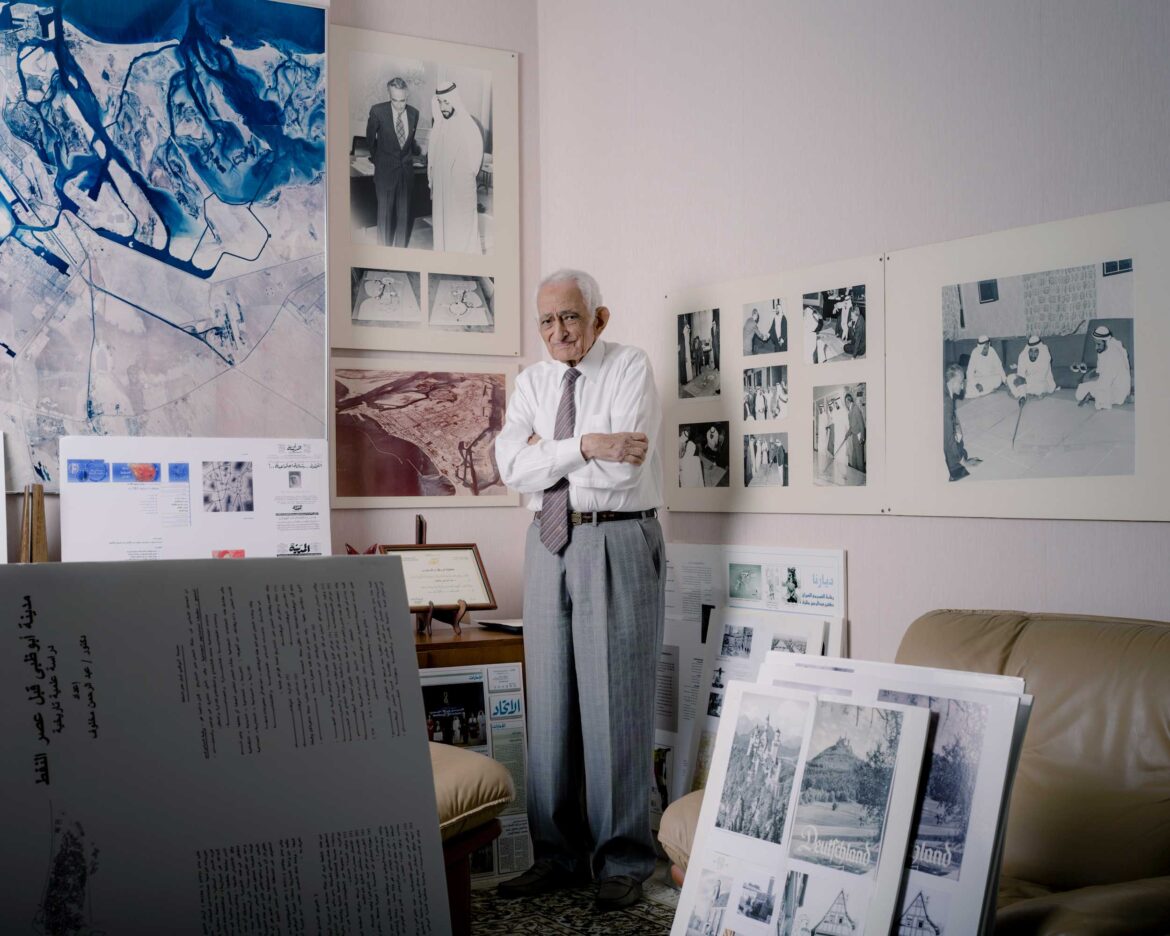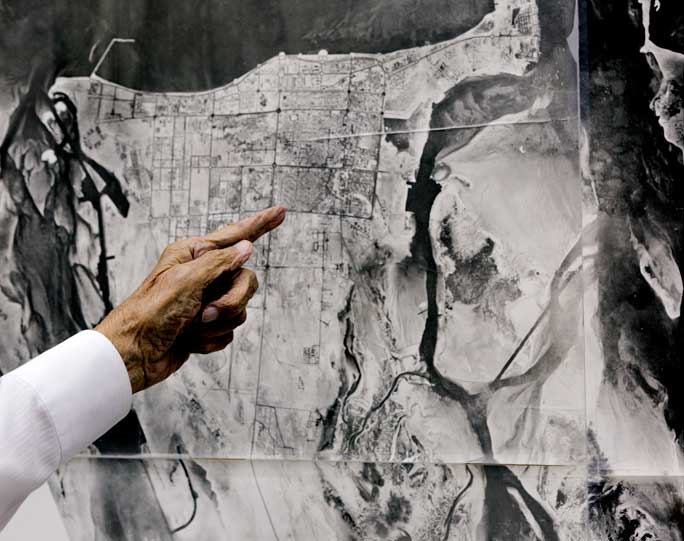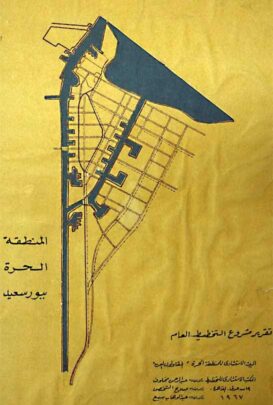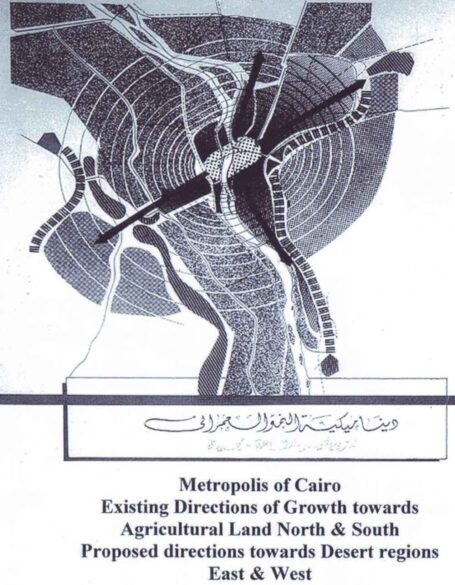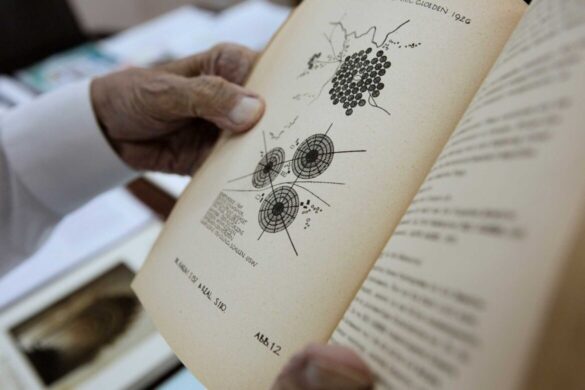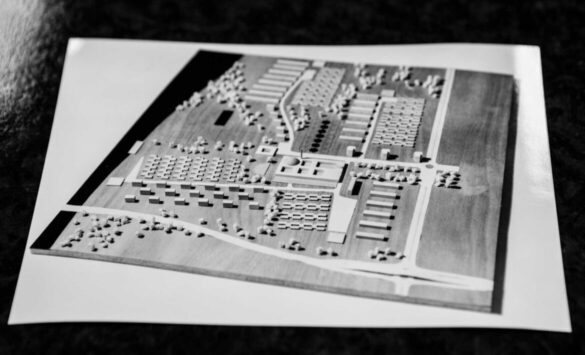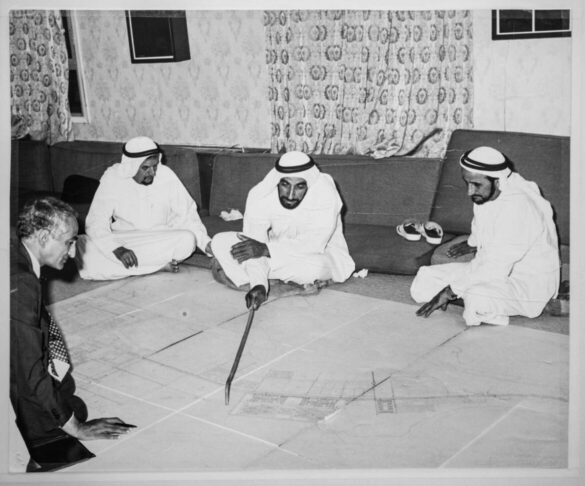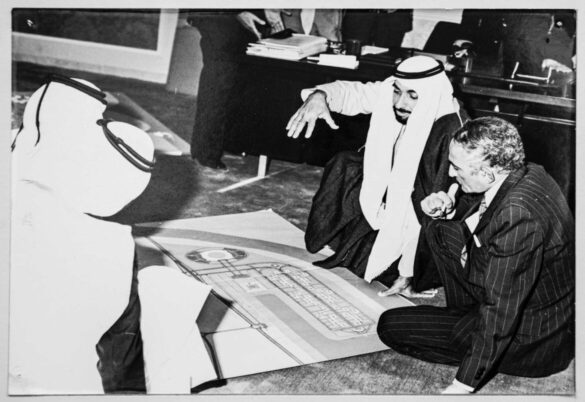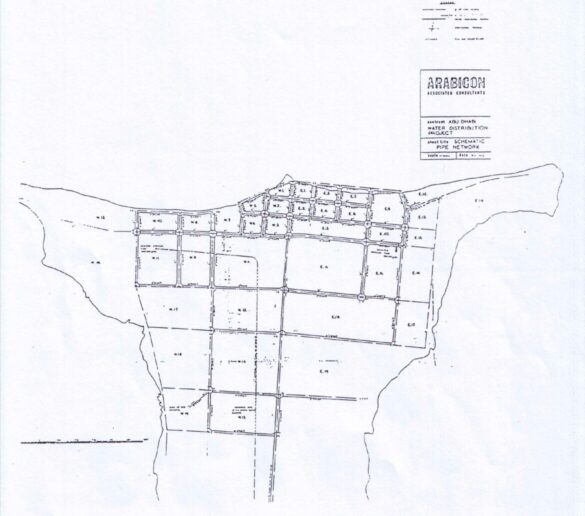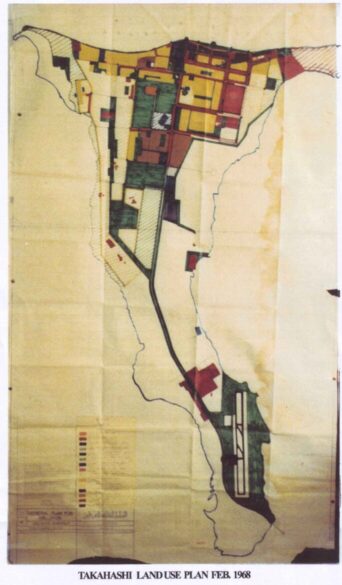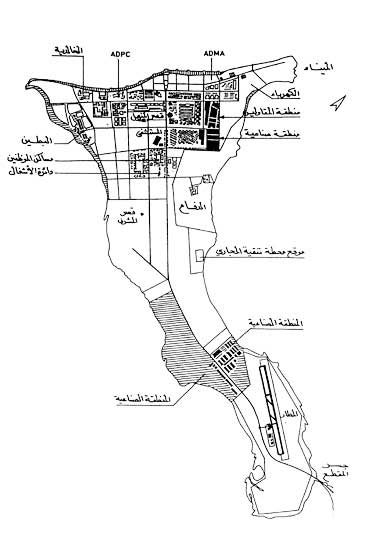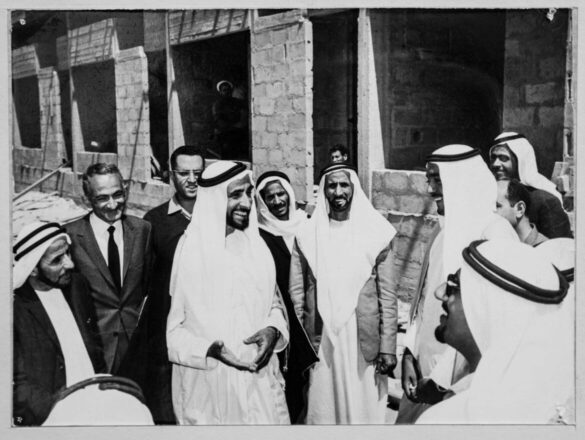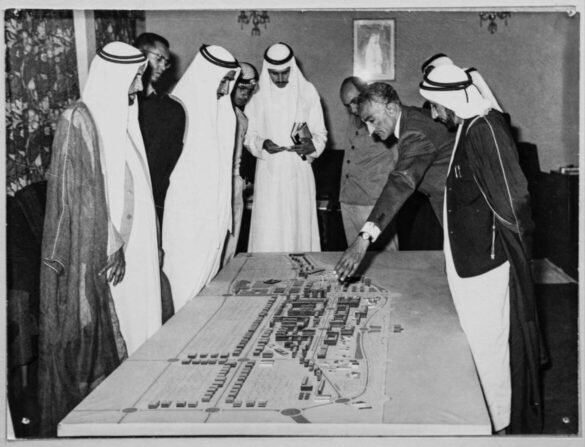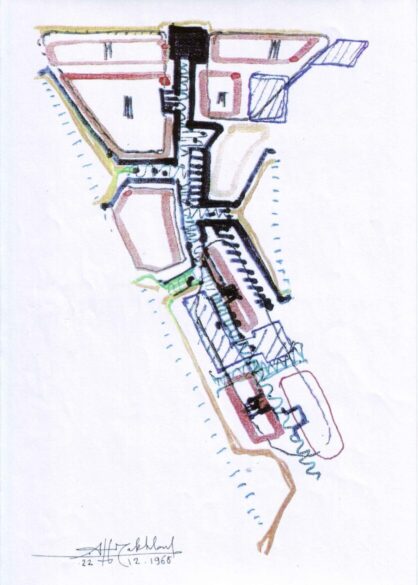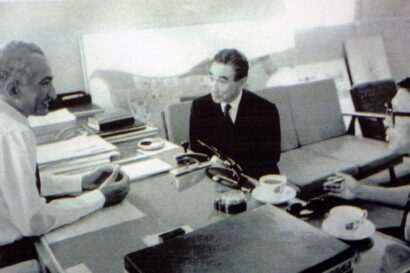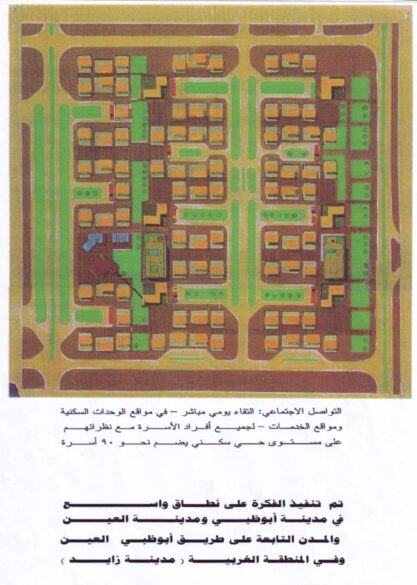So you went to Germany to learn about planning so that you could use that knowledge in Cairo.
My thesis ends with a project proposal in Giza, on the opposite shore of the Nile from Cairo. Then, there was already a bridge to Giza from Cairo to take tourists to the pyramids, but there was little else. I called the area Dar Al Amman, the house of security. I made a design that makes you feel that you are at your house when you arrive at the neighborhood’s entrance. People who lived here would feel they belong to the place and to each other. The social relations among the people are very important.
Nowadays, one hardly knows his neighbors. Maybe you see them at the elevator, but you don’t know their names. We have to design with a sense of neighborhood. That is the social target of the neighborhood unit theory.5
Your proposed site was bordered by the Nile to the east, the road from the bridge to the north, another major road to the west. What is to the south?
This neighborhood unit is bordered by another one. Yes, my thesis includes a district plan with six neighborhood units, each planned for five thousand residents.6 Each neighborhood unit included row houses and multi-story residential buildings. I calculated how many families would live here. Here is a kindergarten. This is a primary school because the theory says that the population would require one primary school. And this is the neighborhood center. I made it this way because it is a traditional Islamic formation of the city. This dome in the center is a mosque. These are other elements, the services for the people, including the shopping.
What makes it traditional and Islamic?
The souk and the shops and manufacturing are clustered together around the mosque. And the size of the neighborhood is expressed in the size of the mosque, within walking distance for the neighborhood’s residents.
And this is a park, which I designed like an Islamic garden or the Taj Mahal. And notice the streets. There are no through-traffic streets, because they would have destroyed any pedestrian life. More details about my study are in my thesis.
Where do the cars go?
The design included garages at the beginning of the lanes. But at that time car ownership was much less. Now, unfortunately, one cannot get around Cairo without a car.
After completing your thesis, you returned to Egypt to begin applying Western planning principles.
I wanted to return to Cairo to teach and I wanted to teach in Arabic, and that meant not just translating English terms. I needed to talk to the hearts of my students.
What did you have to incorporate into planning principles to make them work in Cairo?
In Islam, the right of the neighbor is very important. That means I cannot do whatever I want. I have to consider of my neighbor’s well-being.
How do you incorporate such an idea into a city plan?
It is there in law, as a principle.
But do you see it in the way in which the city is built? Do you see that idea take physical form?
There are two parts to planning: the buildings themselves and human behavior. Still, if I design a residential complex in which everyone can see into his neighbor’s house, then I am affecting residents’ privacy. This is something we have to consider. Still, the ethical and the social parts of planning are the most important.
Then it’s about training people how to live?
Yes, of course. It’s not like animals. Animals are maybe better sometimes. (He laughs.) But laws help. For instance, the law says you cannot build on an entire plot. You have to leave thirty percent as open space. This helps secure a better life.
After returning from Munich, you didn’t remain long in Cairo.
After a year, I was nominated to work for the United Nations in Saudi Arabia. They wanted a Muslim expert who could work in Mecca and Medina. Sayed Karim recommended me, but it also helped that my father was Egypt’s Grand Mufti.7
—Dreams of Mecca and Medina—
During my stay in Munich, I had a dream based on these drawings of the two holy cities. Every morning in Munich before school started, I prayed in the direction of Mecca. I was hoping and dreaming that I would be the planner of these cities. And it happened.
(Dr. Makhlouf shows me a copy of his United Nations identification papers printed on the same board as the drawings of the two holy cities. He asks me to read the title.)
“The bearer of this document is an official of the United Nations holding the title of ‘Expert, Technical Assistance.’” It’s like a passport.
Almost a real passport. The time of building had already started in Saudi Arabia, and I directed it.
In 1958, was Mecca already experiencing a real estate bonanza?
Oh, yes. There were many people looking to become millionaires. That meant there were many who wanted to get rid of me.
Within a few years, you made the first plans for the expansion and redevelopment for which cities?
For all the cities.
Not just Mecca, Medina, and Jedda?
All of them. Yanbu, Jazan …
Also Riyadh?
No, not Riyadh.
Did the greed affect your approach to urban planning in Saudi Arabia?
Greed was not just in Saudi Arabia. It was throughout the region because these countries needed experts from abroad. They needed expatriates at all levels, so then there was competition among expats coming from various places including Britain, America, Iraq, and Egypt. There was a lot of jealousy. Some were upset I did not follow their ways. I could have become a millionaire too.
Could you tell me more about what you were actually doing in Saudi Arabia? For instance, how did you manage the competing influences on the cities’ development?
I made the general plan for Saudi Arabia and then plans for these different cities. In my mind planning is determining whether an idea is either good or bad for the town.
But this was a long time ago. Unfortunately, the human being forgets. There are so many things …
After a few years in Saudi Arabia, you returned to Cairo. Now you had a Ph.D. and significant planning experience. By this time, Cairo was certainly growing at an uncontrollable rate. How could these planning ideas you had been studying have anything to offer such a city?
Of course. I have written about this, about the problems we have, about what we have to do. The target must be to increase people’s income. This can only come from economic production, and everybody must recognize his responsibility in this. A man who is cleaning streets needs to be as honest as a government leader in doing this.
During the time of Mubarak, only a few had the means to make money and become wealthy, just making use of their positions, but not by producing. Egypt has a great past. The Egyptian people are very precious people, even the poorest of us. There is something in them. The Egyptian has tradition in his blood and the feeling of responsibility. Who was it who defended Islam and helped to spread it? Who supported Salah Al Din? Even the prophet praised us.
So what is the way to make modern planning principles work in Cairo?
People just need the means.
More money?
Yes, but it doesn’t take much to raise the per capita income. Different governments have tried to do this, with positive and negative results. But what are they doing for these people? Why did the Islamists win the majority? Because who was there educating and helping people? Islam gives; therefore, nobody can claim that there is something beyond that which is in Islam. For instance, during this financial crisis, I read comments from certain bankers who believe we need to consider [a more widespread use of] Islamic finance.
Let’s go back to Cairo, one of the world’s greatest cities, no doubt. But it seems planning has failed in Cairo. No one even knows how many people live in Cairo because demographics are not reliable. How do we plan, then, when it’s impossible to plan?
There is no impossibility.
Can Cairo be planned?
Yes, Cairo can be planned. It happens partly on paper: the principles and basic elements. We first have to know the problems. Then, we can find the solutions in between.
But the means of doing it is another matter. For example, one solution was to promote birth control. But is that really a solution? No. Because birth rates go down on their own when people are more educated. People who go to school learn how to think. They think about having a family. They have a plan.
So in the end, modernization leads to a sustainable urbanization?
This word “sustainability.” I say this is the most cheating word. What does it mean? It means “no change” at a time cities need to be able to change. Through change is how we take care of our cities.
I heard this word already in 1976, when I was in the US. I was visiting universities, companies, etc. I discovered they were using this word to avoid saying “planning.” Planning is what we need.
Sustainability is like a dance. The word is a fallacy. Nobody is buying it except for rulers. They are saying “we are making things sustainable.” I say sustainability is only for God. We can go at anytime. Does anyone know when he is going to die? There are two things we do not know: what we will earn tomorrow and where we will die. Plan for whatever you plan. But nobody can know what will happen.
—Neighborliness as the Foundation for a Changing Environment—
Islam seems to have a significant role in your life. What kind of role do you define for Islam in urban planning?
Islam gives us the rules of living. There are two Hadiths concerning the neighbor that come to mind. The first one, on the authority of Aisha, is when the Prophet says one should treat a neighbor as a family member. The second Hadith, according to Abu Hurairah, tells that in addition to having good feelings about the neighbor, you should not do anything that annoys him or disturbs him in his own house. He who violates this does not have the merciful God in him.
As town planners, we are trying to provide everyone with what he wants within the given means. We are making the plan to make the city a place of living among neighbors.
If one part of your planning education comes from a religious or moral education and another part from the planning ideas you studied in Munich, can you tell me then how you brought the two parts together?
When I was studying in Europe, I never thought that we would simply copy these ideas in Egypt. We belong to a civilization that we cannot ignore. We have to understand Western planning concepts and see what is good in them. But we should also know what we should not take from them. Islam tells us what is good and bad: halal and haraam.
Are you saying that there are elements of Western planning principles that are unethical?
We have to know where to stop. For instance, when I lived in Germany, I might go to a Kneipe, but I would not drink alcohol. Our personal decisions affect our personal character. Our personal character affects our professional decisions.
So, it seems that you are saying that how one interacts with halal and haraam affects how you are as a person which subsequently affects how you work.
Yes, and everything else.
—Abu Dhabi—
